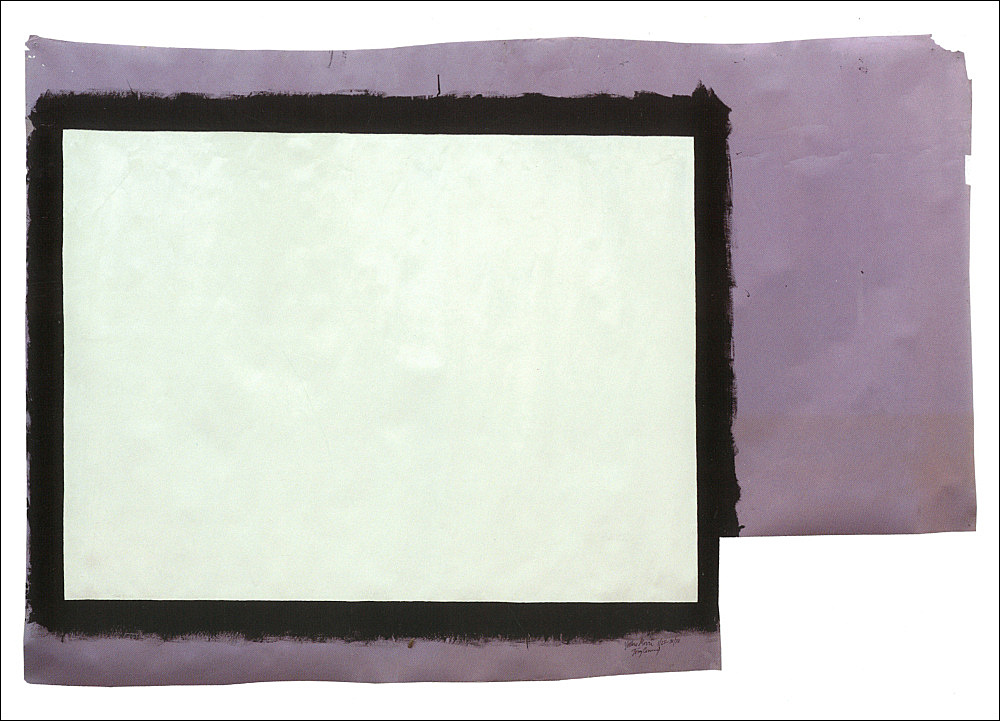

“Yellow Movies”
6 January 2007
opening reception on Friday,
24 November, 7-9 pm
Tony Conrad
“Yellow Movies”
24 November 2006 - 6 January 2007
opening reception on Friday, 24 November, 7-9 pm
If “a movie” is a system of industrial entertainment production, then it is a studio, a camera, a sprocketed strip of transparent plastic, the projection apparatus, and a theater. On the other hand, if “a movie” is the starting point, on a screen, for the viewer’s experience, then it is not intrinsically any of the above. Industrial entertainment uses issues of narrative or design to ensnare the audience, whereas the movie viewer’s experience simply requires the screen image and duration. The Yellow Movie project centers upon cinema as entailing a screen image and duration.
In seeking to dismantle the authoritarian boundaries of film culture during 1972-74 I turned to extended duration as a conceptual armature. The Yellow Movies were a solution to the problem of how to produce films that could run for a lifetime. Only by assaulting and occupying the arena of industrial film-material manufacturing (occupied by Kodak, Fuji, Orwo, etc.) could a movie experience be generated that would change almost imperceptibly slowly -“a movie” that would be very slightly, yet measurably sensitive to light. The emulsion that served this purpose was cheap house paint -or, in the case of the video version, day-glo silkscreen ink.
The Yellow Movies were an intervention, a penetration toward the boundary of cinema. What they are now is something different: gauges of age, anti- monuments, cinematic scrolls from a lost era of formal exploration. But unlike the Dead Sea scrolls, the YM’s were not legible in the time of their own making, and so now invite a double reading. The transitive reading that we are entitled to expect of art works today, announces the YM’s as a system of engagement between cinema and painting, a delivery vehicle that flattens out the service contours of an audience. This seems at first to have little to do with the durational extension of the pieces, their intended darkening and patterning with slow aging; but (like history, which is always in the present) the Yellow Movies also, perversely, reverse the direction of duration, and infer a reading back toward a virtual origin at which the terms-audience, service, transitivity, intervention-were part of a future vocabulary
Tony Conrad, 2006



Tony Conrad
“Yellow Movie”, 1973
emulsion: Gull white flat interior latex, base: studio white seamless paper
295 x 270 cm

Tony Conrad
“Yellow Movie 2/26/73”, 1973
emulsion: Gull white flat interior latex Magicolor No. 3011-11
base: studio white seamless paper
303 x 271 cm
&
“Yellow Movie 3/5-6/73”, 1973
emulsion: clear gloss varnish, Super Valspar No. 10 thin textured
base: studio white seamless paper
290 x 270 cm
installation view, Galerie Daniel Buchholz, Köln 2006

Tony Conrad
“Yellow Movie 3/5-6/73”, 1973
emulsion: Clear gloss varnish,
Super Valspar No. 10 thin textured
base: studio white seamless paper
290 x 270 cm
&
“Yellow Movie 2/28/73”, 1973
emulsion: antique white undercoat,
Provincial colorglazed, Martin Semour Paint No. 226
base: studio white seamless paper
315 x 272 cm
installation view, Galerie Daniel Buchholz, Köln 2006

Tony Conrad
“Yellow Movie 2/28/73”, 1973
emulsion: Antique white undercoat,
Provincial colorglazed, Martin Semour Paint No. 226
base: studio white seamless paper
315 x 272 cm
&
“Yellow Movie 2/21-22/73”, 1973
emulsion: Oak low lustre floor enamel,
Equiti Interior-Exterior Floor Enamel No. 245, Peerless Paint & Varnish Corp.
base: Festival seamless paper
183 x 234 cm
&
“Yellow Movie”, 1973
emulsion: Gull white flat interior latex
base: studio white seamless paper
295 x 270 cm
installation view, Galerie Daniel Buchholz, Köln 2006

Tony Conrad
“Yellow Movie 2/27-28/73”, 1973
emulsion: Citron tinted low lustre enamel, Speedflex latex colorizer,
Brooklyn Paint & Varnish Co.
base: studio white seamless paper
310 x 270 cm
&
“Yellow Movie 1/25-31/73”, 1973
emulsion: Gull white flat interior latex, Magicolor No. 3011-11
base: Lilac seamless paper
185 x 330 cm
installation view, Galerie Daniel Buchholz, Köln 2006

Tony Conrad
“Yellow Movie 3/2-3/73”, 1973
“Yellow Movie 3/4/73”, 1973
emulsion: Odorless White Flat A-C-M Scrubable Nu-Plastic Velvet ba Arthur C. Mangles Industries inc.
base: Riviera Blue seamless paper
440 x 270 cm
&
“Yellow Movie 1/25-31/73”, 1973
emulsion: Gull white flat interior latex, Magicolor No. 3011-11
base: lilac seamless paper
185 x 330 cm
installation view, Galerie Daniel Buchholz, Köln 2006






